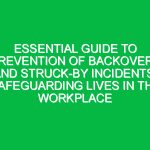When it comes to the construction and maintenance of buildings, the installation of roofing materials is a critical task that demands attention to detail, skill, and most importantly, adherence to Health Safety and Environment (HSE) standards. Ensuring HSE compliance in the installation of roofing materials is not just about following regulations; it’s about safeguarding the health and safety of workers and the environment. This expert guide will walk you through the essential steps and considerations for ensuring HSE compliance in the safe installation of roofing materials, making your construction project a success in terms of safety, efficiency, and environmental protection.
Understanding HSE Compliance in Roofing Installation
HSE compliance in the context of roofing installation involves a comprehensive approach that encompasses various aspects of health, safety, and environmental protection. It requires a thorough understanding of the risks associated with roofing work, including falls, exposure to hazardous materials, and environmental impact, and the implementation of effective measures, such as the use of beam analysis tools, to mitigate these risks.
Key Components of HSE Compliance
- Risk Assessment: Identifying potential hazards and evaluating the risks they pose to workers and the environment.
- Training and Awareness: Ensuring that all workers are adequately trained and aware of the risks and the measures in place to mitigate them.
- Use of Personal Protective Equipment (PPE): Providing and enforcing the use of appropriate PPE to protect workers from harm.
- Environmental Protection Measures: Implementing strategies to minimize the environmental impact of roofing materials and installation processes.
Steps to Ensure HSE Compliance in Roofing Installation
Ensuring HSE compliance in the installation of roofing materials involves a series of steps designed to protect workers, the public, and the environment. Here are the key steps to follow:
1. Conduct a Comprehensive Risk Assessment
Before commencing any roofing project, it’s crucial to conduct a thorough risk assessment. This involves identifying potential hazards, such as the risk of falls, exposure to toxic substances, and environmental impact. Once the risks are identified, evaluate their likelihood and potential impact, and develop strategies to mitigate them.
2. Develop a Safety Plan
Based on the risk assessment, develop a comprehensive safety plan that outlines the measures to be taken to ensure the safety of workers and the environment. This plan should include the use of PPE, emergency procedures, and environmental protection measures.
3. Provide Adequate Training
Ensure that all workers involved in the roofing installation are adequately trained in HSE compliance. This includes training on the specific risks associated with the project, the use of PPE, and the safety plan. Regular refresher training should also be provided to keep workers up-to-date on the latest safety practices.
4. Use High-Quality Roofing Materials
The choice of roofing materials can significantly impact the safety and environmental footprint of a roofing project. Opt for high-quality, durable materials that are less likely to pose health risks or harm the environment. Consider materials that are recyclable or made from recycled content to further reduce environmental impact.
5. Implement Environmental Protection Measures
Take steps to minimize the environmental impact of your roofing project. This can include measures such as recycling waste materials, using environmentally friendly roofing materials, and minimizing noise and air pollution during installation.
6. Monitor and Review
Throughout the roofing project, continuously monitor the implementation of the safety plan and the effectiveness of the risk mitigation strategies. After the project, review the process to identify any areas for improvement and apply these lessons to future projects.
Common Challenges in Ensuring HSE Compliance
Ensuring HSE compliance in roofing installation can present several challenges, including:
- Lack of awareness or understanding of HSE regulations among workers.
- Resistance to the use of PPE or adherence to safety protocols.
- Difficulty in managing environmental impact, especially in urban areas.
- Cost implications of using high-quality, environmentally friendly materials.
Overcoming these challenges requires a commitment to safety and environmental protection at all levels of the organization, from management to workers. It also involves continuous education, training, and improvement in HSE practices.
Conclusion: The Importance of HSE Compliance in Roofing Installation
Ensuring HSE compliance in the installation of roofing materials is essential for protecting the health and safety of workers, the public, and the environment. By following the steps outlined in this guide, including conducting a comprehensive risk assessment, developing a safety plan, providing adequate training, and implementing environmental protection measures, you can achieve a successful and safe roofing project. Remember, HSE compliance is not just about adhering to regulations; it’s about fostering a culture of safety and environmental responsibility that benefits everyone.
Summary of Key Points
- Understanding HSE compliance is crucial for the safe installation of roofing materials.
- Conducting a comprehensive risk assessment and developing a safety plan are essential steps.
- Providing adequate training and using high-quality, environmentally friendly materials are key to ensuring safety and reducing environmental impact.
- Continuous monitoring, review, and improvement in HSE practices are necessary for overcoming challenges and ensuring compliance.
By prioritizing HSE compliance, you not only ensure the safety and well-being of your workers but also contribute to the protection of the environment, making your roofing project a model of responsible construction practices.


